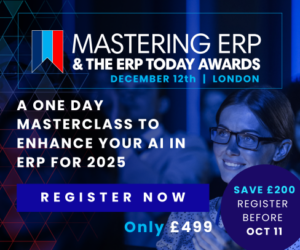Why people-first consultancy is winning from the ground up.
The technology-first approach has lorded over implementations for the past few decades. But cracks in the tower are starting to appear. We meet with Emma O’Brien, founder and CEO of Embridge Consulting, to discover the pitfalls of the current approach and why people-centric system integration is gaining ground.
Delving into the psychology of technology marketing, software vendors have mastered the art of making less than sparkly-looking ERP systems light fires into the C-suites of businesses across the globe, igniting a race to the cloud. Many businesses are convinced that a certain piece of technology is the key to unlocking success, efficiency, and reaching the top. They are sure that when it’s implemented, it will deliver results, and to cap it all off, the promise of a relatively good ROI.
However, investing in new software like cloud-based ERP is not like buying a shiny new car. There is no real cooling-off policy, and after sitting through lengthy implementation periods, you can’t exactly take backsies at the finish line. Nor can you claim a full refund if it doesn’t live up to expectations. But while for some the race to the cloud is complete, with this technology-first approach, the view from the top can leave businesses spent up and underwhelmed. Last year, the Financial Times reported only 37 percent of companies believed they were getting the full value they expected from cloud technology.
At the Kent offices of Embridge Consulting, I met with founder and CEO Emma O’Brien to discuss why companies were encountering ERP pitfalls, and how to build in good implementation practices from the ground up.
“My toes curl when I see how much money has been spent on these digital tool programmes unnecessarily”
O’Brien is immediately a welcoming and warm figure, with an air that suggests this isn’t her first rodeo. After building a successful career in the technology sector, O’Brien branched out, founding the consulting firm back in 2009. Friendly, personable, and rightly proud of her cockney roots, she isn’t woolly with her words. There is simply too much focus on a technology-first approach, she claims.
“Technology is just the enabler. Yes, there are various technology platforms out there, but if they’re in business, they genuinely can do what they say on the tin. One of the common things that you find working with different customers is that they don’t know what ‘good’ looks like. They can quickly get down a rabbit hole, where all their focus goes on what the technology can do and getting wowed by the wonderful pre-sales demos that the vendor puts on show – but that’s probably only 10 percent of the actual solution in achieving a successful change.”
Many public service industry businesses fall into a catch-22 situation with technology implementations. The likes of healthcare, councils, education and not-for-profit organisations (NPOs) generally have more tightly stretched resources and less available funding for big innovation projects. These industries are often too slow to respond to new technology opportunities, while manual processes and siloed archaic systems are decimating the time and motivation of employees.
“They can quickly get down a rabbit hole, where all their focus goes on what the technology can do”
“There’s not enough focus on the people aspects,” O’Brien says, “both in terms of finding an implementation partner with the right industry experience and knowing what their internal teams need to provide for the required inputs of the programme.
“You’ve got to have a good modern technology platform. But if you don’t get all of the other aspects sorted out, it’s going to fail or it’s going to cost a lot more money than you anticipated. It’s not about if the technology can achieve something – it’s about how customers can get a quicker return on investment and come out of a change programme with something fit for purpose, scalable, and which is going to support their futures.”
The need for people-centric SI
With an increasingly implausible amount of micro-knowledge anticipated from software vendors, a crumbling point emerges where vendors offer a ‘solve all’ system without any considerations of the detailed history and evolutionary journey of a business. For the Embridge CEO, this is an issue she often sees in public service organisations, who experience major inefficiencies with their chosen system.
Sold the glitz of the cloud ivory tower, the lure of potential technology upgrades can seem like a fix-all solution to such clients. But with all the implementation considerations, many public service organisations end up finding it either too costly to complete their system implementations, or discover that after all the expense and time to go-live, the system doesn’t work as well for daily tasks and operations as they had hoped. It’s not that the software isn’t a good solution, but the way it’s been implemented simply doesn’t allow these organisations to get the best value out of it for their specific industry requirements. So, for the people on the ground, it’s a system that proves unworkable.
“If you don’t know what that innovation, that function or feature is going to do for your business, then how the hell is that access adding any value?”
This issue often arises from software vendors lacking the necessary micro-industry awareness and from system integrators (SIs) that are inexperienced for that vertical.
“Vendor expertise is in creating the best possible functions and features, and SIs need to be used for a fine-tuned industry-specific experience,” O’Brien explains. “But you can’t provide that proactive advice and guidance to customers unless you know their business. I’ve recognised some really common pitfalls and frustrations in other implementations that needed to have an industry best practice approach. Particularly in the public sector, businesses can get into a pressurised position, focussing on a replacement for a piece of unsupported technology.
“I was seeing a lot of time being wasted, where the customers were being asked to effectively design their own system, particularly when you looked at large-scale public sector and not-for-profit. It’s a bit of a lottery for smaller and mid-sized organisations, too; they aren’t always big enough names to demand the attention or the authority, and so they can get inexperienced people while still being charged the same high day rate fee for a level of service they aren’t actually getting.”
With the price of technology upgrades rocketing, end-user spending on cloud services is expected to grow 20.4 percent this year and reach nearly $600bn worldwide in 2023, according to Gartner, and that’s not to mention the business downtime and implementation costs.
“It just did not rest well with me that it was not good value for citizen money if you’re not doing things in the most efficient way,” O’Brien explains, “and it’s certainly not a good use of donor money if you’re in a not-for-profit environment. There are many, many examples of where you’ve got failed technology programmes and my toes curl when I see how much money has been spent on these digital tool programmes where it’s just not needed.”
Pitfalls with the cloud
For many, O’Brien included, the cloud represents the future of business, with SaaS ERP a welcome solution for managing large, siloed databases. An advantage is that the offering lifts the burden of large in-house IT departments and hardware management that often soak up funding resources better placed on front end services. Gone are the days when businesses use the same version of their software for years on end. With cloud and SaaS technology, it’s never been easier to get the necessary updates and avoid redundancy.
But it is clear that whether getting on top of operational inefficiencies with cloud solutions, creating project profitability or tracking donation transparency, a successful implementation cannot be done without a great deal of knowledge of each organisation’s DNA. By centring implementation on each case’s particular needs and recognising what ground-up users are looking for, SIs will enable a faster route to an organisation’s vision of success.
As with our private devices, upgrades can slip beneath the radar, or are less than helpful. As the CEO confesses, “My kids mentioned playing games in iMessage the other day, and I had no clue it had happened. You don’t tend to think about it when Apple downloads automatic updates to your phone and what will change.
“Now and then you’ll perhaps need a new phone because your phone runs out of memory, or the new operating system doesn’t backdate. Or when you upgrade your Office 365, does the average user know what the additional functions and features will be? The consideration isn’t any different for organisations adopting SaaS-based ERP.”
Not all new features are valuable for each industry, nor each use case. O’Brien argues that businesses need to understand the specific benefits for their case before upgrading or updating software, otherwise it could prove detrimental to their services. On this point, she believes, it’s the people-first approach that secures the stable foundations.
“I don’t think many businesses have really cottoned on to this consideration because we’re still in early cloud adoption days. It’s great that you can access the innovation and get blown away by the sales cycle of a technology vendor, but if you don’t know what that innovation, that function or feature is going to do for your business, then how the hell is that access adding any value? Quite frankly, you’re not going to get the benefit.”
With large backlogs of tasks for the likes of healthcare, education, councils, and NPOs, there isn’t the capacity to read through the fine print of every monthly software update, let alone understand whether it will be useful.

What good looks like
With SIs acting as an effective go-between for the vendor and the end-customer, a better picture can be created of the tools and use-cases that will be most valuable on the ground. For businesses attempting to unpack the complexities of technology partnerships to know what good looks like, O’Brien claims the best SI, vendor and client collaborations come from joint people-centred values.
“The challenge is how you make it more and more intuitive so that you can fast-track adoption of the software as quickly as possible. Part of that comes from the vendor presenting a user interface that’s friendly and as intuitive as possible. But part of it is also about how you implement knowledge transfer as part of the journey to fast-track that knowledge within your user base. It takes all parties to make it work. If your customer is going to get the best return on investment, you don’t want two parties pointing at each other.
“We sign on the dotted line and we enter into a partnership with our customers,” O’Brien continues. “That’s exactly what it is – a partnership. It needs to be a completely open, transparent and collaborative relationship. We select our customers as much as they select us. Everything has to be a collaboration because these are complex programmes, and they never go according to plan.”
The CEO also believes investing heavily in super-user and end-user training and tools, and being able to offer a wide range of complimentary software tools to mould the SaaS package together, is the best way to create successful outcomes. She advises that SIs should never stop looking for better avenues to faster, easier delivery with a network of like-minded partnerships:
“If a customer comes out looking for a wide range of solutions to deliver finance, HR, procurement contracts, management and recruitment,” she explains, “we can knit together ‘out of the box’ with our industry model a number of different technology platforms, and they can know it’s integrated because we’ve done all that work for them.”
Here O’Brien points to Embridge’s partnership with no-code service WalkMe as providing accelerators that the consultancy is looking to develop in the pipeline, making the entire experience of using the software “as easy as possible.”
She also reminds ERP Today that a few years ago Embridge Consulting decided to become an exclusive Unit4 partner.
“From an Embridge Consulting and Unit4 perspective, our go-to-market verticals are completely aligned, creating a fantastic partnership to work with. If those partnerships are also formed with customers from the outset, and you continue to engage with them for a long period of time, and provide that proactive guidance, then they’re going to get much more value from their investment than they ever would do otherwise.”

Putting people over profits
With a people-centric approach, O’Brien explains that it’s not all about the immediate profits, but about securing the end results for both the SI and the customer, retaining customers and staff alike.
“It’s hard for every organisation right now. You’ve got other organisations out there that are really struggling to recruit and then retain their staff. And we’re heading for a bit of a crisis in my view. I think being a people-centric organisation isn’t saying, ‘we’re people-centric’. It’s about what you do and sometimes you get it wrong as well. It’s addressing what you don’t do and just listening to what people say.
“Through the pandemic, our training team ran Zoom sessions with local schools to train them on how to use Zoom and Google Classrooms,” O’Brien shares. “We had the available resources to do it and the schools needed it. We’re continuously trying to think how we can help and that sometimes does come at a cost of compromising profitability. But it’s not all about cost. Profits are important for the valuation of a business going forward, but it’s not the be-all and end-all of everything.”
From apprenticeship schemes, charity fundraising and two-day voluntary leave for outreach work, to flexible working arrangements for parents, older workers and more, O’Brien ensures the Embridge Consulting team can practice what they preach from the ground up.
“It sounds really cheesy,” she says, “but if you’re able to build up a business, and actually be a business with purpose and feel like you’ve got some contribution to your community from a social value perspective, encourage that. Small things can have big impacts.”






